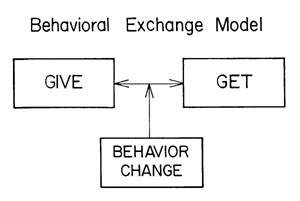Section I: Interactional
or Dyadic Focus
Lecture plan
I. Social exchange
models
-
Role of personality variables
-
Costs and benefits (behavioral economy)
-
What maintains behavior
-
Personal gain vs. communal focus
-
Reciprocity (Quid pro Quo)
Commentary:
These have been generally called "behavioral models."
They emphasize
constructs that implicate situational control of behavior,
focusing on what
spouses do rather than on their personalities.
The consequences of actions
are believed to account for more variance in satisfaction
than personality
variables. They tend to be like business arrangements
applied to "love."
People are often uncomfortable with this notion, that
"love" is negotiated,
that people seek personal gain at low personal cost,
etc. This approach
runs headlong into the voluntary choice, illusion of
choice ideas that are
so prevalent. (Just read some of the postings to the
Marriage list!) The
role of situational control of behavior is very important
in these models.
These models do not spend a lot of time worrying about
the past history of
people. The Halford et al. article tries to show the
changes from the early
behavioral models (BMT) and the newer versions, as described
in his article.
II. Performance
Based Model (OMSP)
The Oregon Marital Studies
Program (OMSP) model is divided into three
major categories:
-
Accomplishments
-
Content Areas
-
Stage of Family Life Cycle

There are four areas of Accomplishment:
-
Objectification
-
Support/Understanding
-
Problem Solving
-
Behavior Change
Every marriage must deal with these accomplishments or marital
"goals."
They are there like air: how well people adapt to these
is important.
Content areas:
-
Appetitive (sought after, desirable)
-
Instrumental (work of the relationship)
-
By-products (the pollution of marriage)
Stages of Family Life Cycle:
Focus on where couple is in stage of family life (newly
married, children,
etc.)
Commentary:
These facets are put together in a 3 dimensional
model (a cube), which
has accomplishments as the front face (columns), content
areas as the rows
on the front face, and stages of family life cycle as
the back or side
facet. This results in a cube made up of 4 X 3 X N (where
N = number of
stages of life cycle). For a given stage, there are 12
boxes which describe
the intersections of accomplishments and contents. In
class I will further
divide the areas in a set of 12. (4 X 12 = 48 cells.)
This model defines assessment and outcome of marriages.
We ask how well
a couple is doing in each "cell." This is a fairly straightforward
behavioral model, but listen closely for how it includes
the "soft side" of
marriage.
Pleasure Sine-Wave:

This is an important conceptual aide that derives from
the OMSP model.
Marital satisfaction and dissatisfaction are not just
bi-polar, but rather
they are separate dimensions. The absence of satisfaction
is not
dissatisfaction! Be sure to copy the drawing of the
pleasure sinewave.
III.
Social Learning Conceptions


-
Coercive control techniques
-
Positive and negative consequences
-
Extinction
-
Dynamics positive and negative exchanges


